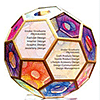BFA Syllabus and Subjects

The BFA subjects cover the study of topics such as the History of Indian Art, Aesthetics, Visual Graphics, Communication, and Design Practice. The fine arts syllabus prepares students to excel in their careers in areas such as animation, textile design, painting, pottery, ceramics, etc.
The BFA course syllabus is designed to help students to become competent design experts and aesthetic designers. Hence, the job scope of BFA is highly extensive in both the private and public sectors.
Table of Contents
BFA Subjects
The Fine Arts syllabus enables students to learn the whole concept of pipelining of production in 2D and 3D animation with the incorporation of in-depth traditional concepts of drawing and painting. BFA subjects are a mix of various concepts based on sculpture, painting, photography, drawing, and several areas of visual arts. Some of the core & elective subjects in the Bachelor of Fine Arts syllabus are given below:
BFA Core Subjects
Bachelor of Fine Arts courses is divided into core and elective subjects that make the course more diverse and flexible for the students. Listed below are some of the core BFA course subjects:
- Appreciation and Fundamentals of Visual Arts
- History of Art
- Pictorial Design/Painting
- Printmaking
- Geometry, Perspective & Calligraphy
BFA Elective Subjects
Listed below are the elective subjects under the BFA course subjects:
- Photography
- Entertainment Design
- Packaging
- Composition Murals
BFA Subjects in Detail
Below mentioned is a detailed overview of topics covered in BFA subjects:
| BFA Subjects | Topics Covered |
| Aesthetics | Nature of beauty, the role of art in society, theories of aesthetics, the historical development of aesthetics, etc. |
| History of Art | About Indian and Western Art, understanding Mauryan to Gupta Art, understanding Christian art, Byzantine art, etc. |
| Computer Graphics | Productivity tools introduction, illustration technique bitmap, vector graphic software, color models, etc. |
| Methods and Materials | Importance of methods and materials, nature & characteristics of drawing & painting media, etc. |
| Print Making | Mono color and Two color techniques, types of inks, stencil, overlapping methods, the process of printing, etc. |
Semester Wise BFA Syllabus
The BFA syllabus provides a comprehensive understanding of the visual arts which includes literature, poetry, music, architecture, and dance. The semester-wise BFA course syllabus is given below:
First-Year BFA Syllabus
The BFA subjects 1st year are inclined towards the fundamental aspect of the course. The table below contains the fine arts subjects for 1st year:
| Semester I | Semester II |
| History Of Art | Geometrical Drawing And Perspective |
| Composition | Design |
| Painting | Visual Graphics |
| Sculpture | Printmaking |
Practical Topics in the BFA Subjects 1st Year
Some of the practical fine arts subjects for 1st year are given below:
- Practical mural work on board using painting mediums
- The practical method of assemblage
Second-Year BFA Syllabus
The table below contains the subjects from the Bachelor of Fine Arts syllabus for the second year:
| Semester III | Semester IV |
| Aesthetics | Assemblage |
| Printing Techniques | Sculpture Methods And Materials |
| Carving | Lettering And Typography |
| Sculpture ( Study From Life) | Computer Graphics & Animation |
| Ceramics | Project |
Practical Subjects in the 2nd Year BFA Syllabus
Some of the practical topics in the second-year BFA course syllabus are given below:
- Practical assemblage training on working surfaces
- Preparation of typographical layout, logo design, Book jacket, and Book Cover
Third-Year BFA Syllabus
The table below contains the subjects from the BFA course syllabus in the third year:
| Semester V | Semester VI |
| Book Art | Aquatint |
| Script Writing | Drawing For 2d Animation |
| Digital Imaging | Serigraphy |
| Clay Modeling | Electives |
| Electives | Project |
Practical Subjects in the 3rd Year BFA Course Syllabus
Some of the practical subjects in the third-year BFA course syllabus are given below:
- Practical mural work on board using painting mediums
- Making suitable layout designs for mural work
Fourth-Year BFA Syllabus
The 4th-year BFA course syllabus focus on the practical application of topics through the thesis or project work in the final year. The table below contains the subjects from the Bachelor of Fine Arts syllabus in the third year:
| Semester V | Semester VI |
| History of Art | Metal Casting |
| Aquatint | Textile Design |
| Serigraphy | Electives |
| Electives | Project |
Practical Subjects in the 4th Year BFA Course Syllabus
Some of the practical subjects in the third-year BFA subjects are given below:
- Practical mural work on a slab using mosaic tiles
- 3D forms in thermo coal & cardboard
Note: The BFA course Syllabus can differ based on the diverse academic structure in different colleges. However, students can access the new fine arts syllabus pdf version to know more about the course curriculum.
Specialization Wise BFA Syllabus
BFA course offers various specializations which students can select according to their interest area and future goals. Listed below is the general syllabus for BFA specializations:
BFA Applied Arts
The BFA Applied Arts course gives students a comprehensive understanding of various art forms and their practical applications. The syllabus covers a wide range of topics including calligraphy, clay modeling, animation, graphic designing, etc. Some of the subjects in the BFA Applied Arts syllabus are given below:
- Calligraphy & Drawing
- Clay & Plaster Modelling
- Silk Screen, Stencil Print
- Drawing and Illustration
Read More: BFA Applied Arts Syllabus
BFA Painting
The BFA Painting course equips students with an understanding of painting principles and techniques. The topics covered in the BFA Painting course are color theory, composition, brushwork, and the use of various painting materials, along with common topics like the history of arts, aesthetics, etc. Some of the subjects in BFA Painting syllabus are given below:
- Drawing from Memory, Manmade & Nature
- Drawing from Life
- Drawing from Outdoor Sketching and Landscape
- Computer Graphics
BFA Textile Design
The BFA Textile Design course focuses on a theoretical and practical understanding of textile designs and their principles. A few of the topics that are covered in the syllabus are material selection, pattern making, and textile printing. The course also has practical and research projects in the syllabus. Some of the subjects in the BFA Textile Design syllabus are given below:
- Fabric Structures
- Fashion Illustrations
- Fabric costing
- Tapestry
BFA Course Structure
The BFA course is designed to provide students with the theoretical and practical framework of the visual arts through lectures, seminars, studio work, etc. In the final year, students are expected to work on a research project to gain practical exposure. The course structure of the Bachelor in Fine Arts course is as follows.
- VI Semesters
- Core Subjects
- Elective Subjects
- Research Projects
BFA Teaching Methodology and Techniques
The BFA teaching methods primarily focus on introducing students to essential aspects of fine arts through both traditional and practical sessions. Listed below are the teaching methodology and strategies in general:
- Traditional Classroom-Based Teaching
- Seminars
- Group Projects
- One-to-One Sessions for Research Dissertation
BFA Projects
BFA research project helps the students to understand and learn about a subject in greater depth and detail. It allows the students to get exposure in the areas of research methodology, ethics, and techniques. Some of the popular research projects in the Bachelor of Fine Arts syllabus are listed below:
- Exploring the part played by fine arts in the online world. What are the ways fine arts can be incorporated into website development?
- Is the transition to digital films affecting cinematic art adversely? Are ally wiping out the pleasure of watching movies?
- Can motion capture acting be considered genuine acting? Should the motion capture actors have the privilege of getting awarded like the real actors?
- Can video games be considered fine art?
BFA Reference Books
There are plenty of reference books in the market that students can rent or purchase. These books can help the students understand the concepts better and can also help them ace the course. Listed below are some of the popular books in the Bachelor of Fine Arts syllabus are given below:
|
Name of the Books |
Authors |
|
Designers Poster |
Rockport |
|
Designer's Guide to Colour |
James Stockton |
|
Commercial Art Techniques |
Raviraj |
|
Color- A Workshop for artists and designers |
David Hornung |
|
Calligraphy Today |
Ajit Mukherjee |
Top BFA [Bachelor of Fine Arts] Colleges
Top Arts Entrance Exams
BFA Fee Structure
FAQs on BFA Syllabus and Subjects
Q: What are the theory subjects in BFA?
Q: What are the popular BFA thesis topics?
Q: Which are the important BFA 1st year books?
Q: What is BFA 1st year syllabus?
Q: What are the elective subjects in the BFA course?
Q: What is the BFA entrance exam syllabus?
























